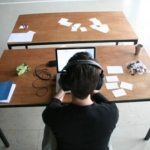Every company has little backstage rituals. In the case of Dancemakers’ new show, loveloss, the performers’ post-show routine involves huddling in a corner and dumping sand out of their underwear.
“We keep that sand in a separate pile instead of recycling, since it’s been in their crotches,” laughs choreographer Michael Trent. “They used to get it in their ears and eyes a lot, but they’re learning better how to avoid that. There’s a lot of flesh in the show, but that started for the practical reason of taking off their clothes to cover their faces when the sand is blowing around.”
Despite the near nudity and beachlike setting, loveloss is hardly sunny. Trent often veers toward the intellectual in his work, but this piece began with a deeply personal need to sort through the questions posed by the unexpected death of his mother.
“The reason you’re in the world has disappeared, and there’s something very primal in that,” he says. “We started with discussions around ideas of loss and very quickly came to what happens after a loss. The feeling of being alone, possibly even abandonment. The destabilizing effect where things that are taken for granted are questioned.”
Like the content, the work’s structure marks a departure for Trent. While his quintet of dancers operate within a set frame, the show is largely improvised – a shift from his usually precise pieces.
“The first responses dancers give in rehearsal are always so rich, and I’ve been working the last few years to reconcile those gorgeous moments in the final work,” he says. “It became clear to me this project was going to be the most improvised thing I’ve made in my life.”
Loss and randomness also percolate through the musical score, much of which comes through record players operated by the performers. In lieu of traditional LPs, composer Christopher Willes opted to record music on dubplates, low-quality discs that can play only a few times before they begin to degrade. Over the run, elements of the music gradually disappear as the format slowly disintegrates.
The audience is seated in a single row of chairs surrounding the stage; each seat is literally front row. Besides eliminating the need to peer around a fellow theatregoer’s obtrusive hairstyle, the arrangement acknowledges Trent’s positioning of the work for the public. As with experiences of death and loss, each person has their own unique view on the material.
“I’m always wary of people who make claims of sharing moments that are universal in art,” Trent says. “I’d rather promote this idea of the uniqueness of each experience in the room. The orientation of the space also puts the viewer in a place where they have to observe themselves and others in relation to the thing they are watching. It enlivens the space for thinking about your response in the context of others around you, which you can often avoid in a traditional proscenium staging.”


 Why you can trust Xtra
Why you can trust Xtra


